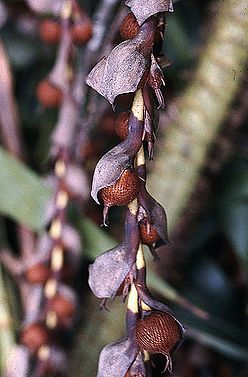Plectocomia mulleri
| Plectocomia (plehk-toh-cohm-EE-ah) mulleri (myoo-lehr'-ee) | |||||||
|---|---|---|---|---|---|---|---|
 Pahang, Malaysia. Photo by Dr. John Dransfield, Royal Botanic Gardens, Kew/Palmweb. | |||||||
| Scientific Classification | |||||||
| |||||||
| Synonyms | |||||||
|
| |||||||
| Native Continent | |||||||
|
| |||||||
| Morphology | |||||||
| |||||||
| Culture | |||||||
|
| |||||||
| Survivability index | |||||||
|
| |||||||
| Common names | |||||||
|
| |||||||
Contents
Habitat and Distribution
Widespread on poor soils at altitudes up to 920 m above sea level. Elsewhere throughout Borneo; also in Peninsular Malaysia.Description
Solitary or clustered moderate to robust rattan climbing to 30 m or more; stem without sheaths 2-10 cm in diam., with sheaths 3-15 cm in diam. (rarely even more), internodes to about 30 cm long. Sheaths without knee, bright green armed with rather close full or partial whorls of brown spines to 2 cm, the spines united by their bases to form collars, buff indumentum abundant on newly emerged sheaths. Leaves very variable, 2-7 m including the cirrus (1-3.5 m) and petiole 10-20 cm; leaflets to 35 on each side of the rachis, arranged irregularly in groups of 2-5, fanned within groups, the longest to about 40 × 3.5 cm, dark green on the upper surface, same colour beneath except in populations in kerangas where usually chalky-white beneath. Inflorescences produced simultaneously from up to 32 nodes in male, usually fewer in the female. Male inflorescence longer than the female, to 1 m with up to 40 pendulous branches to 30 cm; bracts to 2 × 1.5 cm, truncate with short triangular tip, subtending 60-100 flowers. Female inflorescence to about 40 cm, bearing about 6 pendulous branches to 50 cm; bracts to 3.5 × 2 cm, truncate with short triangular tip, subtending 2-4 flowers. Mature fruit ± rounded, 2-3 cm in diam., tipped by stigmatic remains and covered in about 65 vertical rows of fimbriate chestnut brown scales. Seed about 1.5 cm in diam. Seedling leaf lanceolate, undivided. (J. Dransfield, The Rattans of Brunei Darussalam. 1997)/Palmweb. Editing by edric.
Plectocomia mulleri is particularly abundant in forest on poor soils, especially where the forest has been disturbed. It is very characteristic of some facies of kerangas. In Borneo it ranges from the lowlands up to about 1,400 m above sea level. It is very variable, so much so that extremes look remarkably different from each other. The leaflets vary from being concolorous to strongly discolorous, but even those individuals which appear concolorous carry indumentum on the lower surface of the leaves at the shoot tips. Individuals on extreme kerangas soils have small narrow leathery dark green leaflets, densely chalky white beneath. However, flowers and fruit characters link all these populations together as one variable species. (J. Dransfield, The Rattans of Brunei Darussalam. 1997)/Palmweb.
Culture
Comments and Curiosities
Etymology: Specific epithet in honor of Salomon Muller, early German collector in S. Borneo.
- IMAGE GALLERY
External Links
References
Phonetic spelling of Latin names by edric.
Special thanks to Geoff Stein, (Palmbob) for his hundreds of photos.
Special thanks to Palmweb.org, Dr. John Dransfield, Dr. Bill Baker & team, for their volumes of information and photos.
Glossary of Palm Terms; Based on the glossary in Dransfield, J., N.W. Uhl, C.B. Asmussen-Lange, W.J. Baker, M.M. Harley & C.E. Lewis. 2008. Genera Palmarum - Evolution and Classification of the Palms. Royal Botanic Gardens, Kew. All images copyright of the artists and photographers (see images for credits).
J. Dransfield, The Rattans of Brunei Darussalam. 1997
Many Special Thanks to Ed Vaile for his long hours of tireless editing and numerous contributions.












